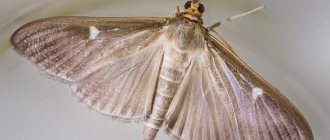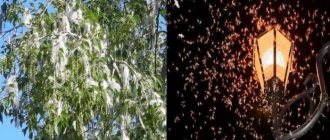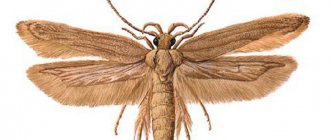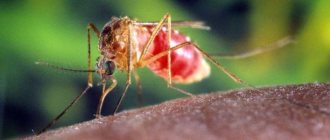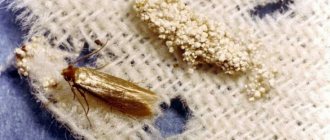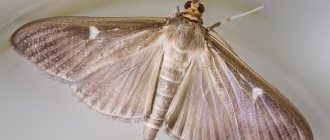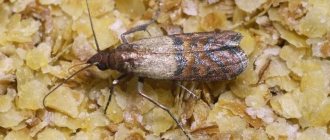Some types of moths have chosen human homes and gardens, turning into malicious pests. In nature, there are several hundred species of moths - inconspicuous butterflies that are mainly nocturnal. Some types of moths have taken a fancy to human homes and gardens, turning into malicious pests. They destroy things, especially furs and fabrics; settle in products, contaminating them and making them unsuitable for food. Where do moths come from, what species inhabit our homes and how do moths reproduce - the answers to these questions will help you cope with pests.
food moth
The food or fruit moth is an ugly gray butterfly with a wingspan of up to 9-10 mm. The moth looks inconspicuous in a static state due to the fact that it folds its wings in a special way - they are narrowly folded.
There are several types of food moths and they are all considered pests in the home.
There are several types of food moths and they are all considered pests in the home. They prefer to settle in houses, barns, granaries, vegetable stores, warehouses, and shops. It is in these places that food contamination by their larvae occurs. Flour moth prefers flour and cereals; fruit - dried fruits, mushrooms, spices, tea, herbs, nuts. Similarly, various types of moths can be found in cereals and dried fruits. To a person who is not an entomologist, all these species look the same - gray small butterflies with an unclear dark pattern on the wings.
Moths are nocturnal insects. During the day she hides in secret places and sleeps.
Types of moths in the apartment
Most often, one of the following five varieties of moths can be found in an apartment. Outwardly they are very similar, however, each species has its own food preferences . That is, if you find grain moths, you can rest assured about the integrity of your clothes, and vice versa.
- House moth (clothes moth) – has a faded, yellowish color with barely noticeable purple tints. Lives in dark closets with a lot of clothes made from natural fabrics - wool, linen, silk, velvet and feathers.
- Furniture - a gray , inconspicuous moth whose larvae live in foam rubber , upholstery of chairs, sofas and carpet pile . Parasite infestations are transferred from one piece of furniture to another . Most often this happens in furniture warehouses, or after purchasing a used interior item.
- Kitchen - most often starts in closed, unventilated containers with flour, cereals and grains. They get into the apartment from the store if the integrity of the product packaging has been even slightly damaged.
- Cereal – consumes both bulk and non-bulk products. The presence of small gray moths in the kitchen indicates the need for general cleaning and sorting through all the grains for larvae.
- Grain - found on land where grain crops are grown and in barns where the harvest is stored . Sometimes it can move into living quarters. Adults of this species look like small gray-yellow moths . The back side of their wings is silvery.
not to eat food products in which moths have been found even though they are disinfected after heat treatment. The fact is that of insect activity or even small may remain . For example, grain moth caterpillars gnaw holes in grains and live inside until they enter the moth stage.
Physiology
The adult moth lives up to 3 weeks. Some types of fruit moths live for several days, during which their task is to lay eggs. The moth goes through development stages: eggs - larval stage - pupa - adult insect. The moth reproduces quite quickly - food moths hatch up to 6 generations per year. Having laid eggs, the moth dies within a few hours. The insect itself does not eat as an adult, it only drinks. The moth lays eggs in foods, which are the food source for the larvae. Moth eggs are white.
The moth lays eggs in foods, which are the food source for the larvae.
The larva of the food pest looks like a light brown moth caterpillar, whose size can reach 2 cm. As soon as the larva is born, it begins to gnaw food. In this stage of development, the moth exists longer than in the adult stage - up to 60 days. This makes it clear why moths manage to cause so much damage to products and the economy as a whole. The larvae are inactive and remain in the environment in which they hatched from the eggs.
What does a mole look like?
The house moth is small moth from 5 to 8 mm with wings folded into a triangle. In the wild, wings folded into a tube and a pyramid are also found.
They have a nondescript, camouflage color that serves as protection from predators. Most often, the wings are colored in gray-brown and yellowish shades. They do not have a proboscis, since moths do not need to replenish their energy reserves. On the contrary, moth larvae have a fairly powerful jaw , with which they can gnaw through hard seeds, fruit seeds and durable tissues . In appearance, the larvae are a translucent, brownish caterpillar with a strong dark brown head.
The scale of sabotage
Food moths destroy food supplies, infecting them with waste from their vital activity. Eating such foods is dangerous for humans. This may cause:
- allergic reactions;
- food poisoning;
- weakening of the immune system.
An allergic reaction is a consequence of food contamination with food moths
All products where moth larvae were found must be destroyed, which leads to large losses.
Reproduction
In order to prevent the spread of insects in your home, you need to know how moths reproduce. For all species that appear in apartments and houses, this happens the same way.
The stages of development of these flying insects are:
- Laying eggs.
- The emergence of larvae.
- Transformation of larvae into pupae.
- The appearance of butterflies.
The female searches for partners for mating by characteristic odors. At one time, she can lay from 50 to 350 eggs measuring less than 1 mm. The emergence of larvae from eggs, depending on the air temperature, occurs after 2-3 weeks. The larvae feed very actively, and it is they, and not the butterflies themselves, that cause the main damage to humans.
Under favorable conditions, after 35-50 days, having weaved a hard cocoon, the larva turns into a pupa. As the pupa develops, it changes color, and eventually its color becomes characteristic of an adult butterfly. The transformation from pupa to adult occurs in 1 to 4 weeks. Immediately after the appearance of the butterfly, the reproduction process begins. When temperatures are favorable, reproduction occurs all year round. If we talk about how long a moth lives, then in adult individuals this period is 1-2 weeks.
Clothes moth
Another type of moth prefers to feed not on cereals and fruits, but on things - primarily fur, wool, fabric fibers, and less often - leather. This is the so-called clothes moth, which often appears at home in the summer. The moth feeds on any foods containing keratin protein. Accordingly, animal fabric (wool), fur, leather are suitable for this. If a moth damaged a fabric considered to be synthetic, it means that it contained up to 20% wool fibers.
Clothes moths feed on things - primarily fur, wool, fabric fibers, and less often - skin
What do moths eat?
Moths are quite picky insects when it comes to food. House moth larvae prefer exclusively natural fabrics without impurities, especially cotton, silk, fur, and feathers. eliminate the possibility of appearing in the closet using a special scented liner or spray.
Attention! First of all, the larvae begin to eat old or dirty clothes, eating holes in them. Regularly audit your closet and throw out what is no longer wearable.
Furniture moths devour furniture upholstery and its filling . As with clothing, worn and damp areas are the first to be affected Kitchen moths, cereal moths and grain moths are three subspecies of one species - fire moths. Her diet includes the following food groups:
- flour;
- cereals;
- dried fruits;
- pasta;
- candies.
As for drinking, moths drink exclusively water, and this distinguishes them from other household pests such as ants or cockroaches, which are not averse to enjoying sweet tea or alcohol. The thing is that the moth’s body simply not able to absorb anything other than water.
Appearance and physiology
The clothes moth belongs to the species Tineola bisselliella. It looks like a small butterfly up to 16 mm in size. Butterfly wings can be dirty yellow or golden in color. Clothes moths move curiously - adult butterflies fly poorly or cannot fly at all, although they have wings, they run quite quickly across the surface of textiles.
Clothes moths prefer dry air, so they feel great at home, especially in winter when the central heating is on.
Moth diet
Moth is not a product of light industry and civilization. Those butterflies that cause damage to clothing are able to lead an active life outside the walls of a person’s home. Clothes moths lay eggs in bird nests and rodent burrows. Shed fur or feathers are the main, but rather meager, food for the larvae.
Unstable temperature conditions prevent butterflies from reproducing quickly, so they often have to spend the winter in the form of pupae.
If we talk about what food moths eat in nature, then the main sources of their nutrition include seeds and nuts.
Very often it lives in the reserves that animals make for the winter.
But still, the insect feels most comfortable in a human home. After all, there you don’t have to survive on random food. Cereals, fur, wool and cotton fabrics are usually always available, and in unlimited quantities. Moths spoil clothes completely randomly - holes in a sweater or tracks in the fur can appear in a variety of places. Their number directly depends on how many larvae are on the contaminated surface.
The main difference between moths and other butterflies
Butterflies need a proboscis to properly feed on flower nectar. It is with its help that the insect reaches the aromatic nectaries of plants. For most butterflies, nectar is the main food. But almost 2,000 species of adult moths do not feed at all, so they do not need a proboscis. This is the answer to the question why moths do not have a proboscis.
It should be noted that in adult moths the digestive organs are underdeveloped. The task of adult butterflies is to reproduce offspring, so they live off what they accumulated in the larval stage. During this period, females try to move little, and males fly exclusively in the dark.
Types of moths and their ways of entering the home (video)
Each moth lays up to 200 eggs. They are oval in shape, up to 0.6 mm in size. Moth caterpillars reach a length of a centimeter. They are yellowish in color, but are capable of changing their skin several times during their life. At this stage of development, the larvae can live from 70 to 200 days. The cooler the house, the longer the larval stage. In unfavorable conditions and in the absence of food, the larva can exist for up to 2 years. The clothes moth produces only one generation per year, which is determined by the feeding conditions of its larvae and the duration of their development.
Where do clothes moths come from?
What causes moths to start in an apartment is something everyone should know, because sometimes even the most neat, ironed and cleaned things turn out to be infected with this scourge. A butterfly or eggs can get into your home in a variety of ways. If a person suddenly develops furniture moths, this probably happened after purchasing furniture - sometimes even new.
In carpets made of natural wool, these insects also migrate to the new owner straight from the store. Fur items stored in stores for a long time may also be infected with the parasite. It is not difficult to understand that you can expect tricks even more often from worn clothes or other items that are not new.
In addition to the indicated paths, there are other directions where moths in the house come from:
- A butterfly may accidentally fly into an open window. Further reproduction of butterflies is possible if such an individual turns out to be a female. Usually the insect flies outside in the evening in the summer, so it is recommended to have mosquito nets on the windows.
- Insects often fly in through doors. They hide in the entrance, waiting for the right moment to enter the owner’s home. This happens more often in the evening - when the door opens, butterflies fly into the light.
- Moths can also enter the house from neighbors through ventilation. Therefore, ventilation grilles must be strong, undamaged, and cleaned regularly.
- Occasionally, if there is a moth infestation, this is due to the introduction of its eggs from the fur of dogs. This is possible when the pet belongs to a long-haired breed. Butterflies can lay eggs on animals as temporary housing, and if purchased, in addition to the dog, the owner will become the owner of harmful insects.
Help: It is a mistake to think that butterflies and their caterpillars breed when sanitary standards are not observed, in dirty, uncleaned rooms. The reasons why moths appear are not related to dirt and dust - these parasitic insects only need suitable food.
Damage caused
Clothes moth caterpillars eat holes in fabrics and turn fur into dust, destroying its fibers to the core.
You can also learn about methods and means of fighting moths in the closet by reading the corresponding article on our website.
To protect your home from clothes moths, you need to carefully check all things brought into the house.
Preventing moths
To protect yourself from food moths appearing in your home, you must follow these tips:
- When purchasing products in a store, carefully look at the integrity of the packaging. It would be useful to try to consider the contents of the package. If something confuses you, it is better to refuse the purchase.
- You should not buy groceries in advance to prevent insects from spreading and harming your food.
- Cereals should be stored in hermetically sealed transparent containers.
- Regular inspection of the contents of kitchen cabinets, washing and airing them will also help protect yourself from unnecessary tenants.
To prevent moths from infesting your wardrobes, you should follow basic hygiene rules: ventilate and wash your things more often, and do wet cleaning of the premises. Before long-term storage or for preventive purposes, things can be taken outside into direct sunlight or frost.
Ways to get into the house
Where do clothes moths come from in the house? It enters the house in approximately the same ways as food:
- through open windows and doors;
- together with old things affected by moths;
- through the ventilation holes.
To protect your home from clothes moths, you need to carefully check all things brought into the house. Special attention should be paid to various antique items that have old textiles, leather or fur. Moth larvae can live here, which, under favorable conditions at home, will reach the adult stage and begin to reproduce.
Moth - types of butterflies
There are several types of moths that literally distribute “spheres of influence” in a person’s apartment. All of them are divided into two groups - food moths and clothes moths. As the name suggests, some butterflies parasitize on food, while others parasitize on the host’s things and clothes. The following types of moths are distinguished:
1. Fur coat. The yellowish butterfly itself, up to 1.6 cm in size, does not harm humans, since it does not eat anything. Its main goal is to lay several clutches of eggs, from which voracious larvae emerge. Outwardly, they resemble worms and have a white translucent color. Worms eat the fur of fur coats, hats, collars, and gnaw holes in them. In a matter of days, the fur turns into a sieve.
5 effective ways to remove moths from a fur coat
2. Clothes. The size of the butterfly is up to 2 cm, its wings are yellow and purple at the base. The caterpillars look the same as those of the fur moth, but they settle in the folds of various fabrics and clothes with wool. The butterfly lays its eggs directly on the inside of the fabric, and after the caterpillars hatch, they immediately begin to feed.
Clothes moth: features and control methods
3. Furniture. In the house, she begins to lay eggs on the upholstery of furniture, as well as in the cracks of wood. The caterpillars eat the upholstery and then move onto the wood. The butterfly is small, up to a centimeter with a wingspan, light yellow in color with brown wing bases.
4. Carpet. The larvae of this butterfly eat carpets, fur, and even leather products - bags, boots. This moth almost does not react to standard means - camphor and naphthalene - so it can sometimes be difficult to remove it.
Attention: An untrained person cannot distinguish a food moth from a clothes moth, but there is a big difference between them. This type of butterfly lays eggs directly into food products - nuts, cereals, flour, and the larvae intensively eat them.
Methods for killing moths (video)
No matter where the moth appears in the house and no matter what genus it belongs to, at the sight of nondescript, chaotically flying butterflies, you should get excited and take all measures to destroy them. This will save food and things from spoilage and save a lot of money. Today there are many ways to combat moths, allowing you to get rid of them efficiently and in the shortest possible time.
Effective methods of moth control
First of all, you should accurately determine that a moth has appeared in your home and what kind of moth it is. It is equally important to analyze the routes of infection, otherwise pest control may be useless. After this, you can safely begin to solve the problem. The next stage is the choice of a control method, using either chemical means of control or traditional methods, as the safest for humans and domestic animals. Much depends on the degree of infection.
The main attention should be paid to the destruction of the larvae, since they are the ones who cause the main harm.
In order for the struggle to have a positive result, it is advisable to rely on 5 rules. Here they are:
- First you need to do an audit of the food that is stored in the boxes. As a rule, cereals, flour, dried fruits, etc. are stored this way. These are the foods that moths love. Inspect the closets in which clothes are stored. Each item should be carefully inspected. Even if moths were not found, it is still better to disinfect the storage areas. To do this, just use a soap-soda solution or vinegar solution. For prevention, in such places you can leave bouquets of plants such as wormwood, mint, tansy, etc.
- If damaged items are identified, it is better to sort them according to the degree of deterioration. If the damage is severe, it is better to throw the items away immediately, and if the damage is weak, the items can be washed or dry-cleaned.
- In case of damage to fur products, it is also necessary to assess the damage, and it is better to entrust the cleaning of the products to specialists, otherwise such expensive products can be completely damaged.
- Analyze the situation to determine the source of infection and take all measures to prevent moths from appearing in your home again. Often housewives themselves are to blame for the fact that this voracious pest appears in the house.
- If the rules for storing some things made of natural fur or bulk food products have been violated, then it is better to correct all mistakes. Mistakes can be the following: things are not taken out into the fresh air, into the scorching sun or into the cold, anti-moth products are not used, and bulk food products are not stored in closed containers.
Chemicals
You can get rid of moths using Dichlorvos. This drug, labeled “Neo,” is odorless, and the aerosol is very easy to use. The drug is sprayed in closets where clothes were stored and where butterflies were noticed. It should be remembered that the drug is toxic and it is necessary to work with it in protective clothing. In any case, the packaging indicates how to use it correctly. Strict adherence to the instructions allows you to get the maximum effect without negative consequences for others.
You can also use other drugs, such as “Clean House” or “Armol”. You should also remember the fact that the use of such substances is prohibited if there are children, allergy sufferers or expectant mothers in the house.
There are special tablets, as well as sections that are placed in closets where clothes are stored. At the same time, the substance slowly evaporates and has a detrimental effect on the moths, after which the insects and their larvae die. Such remedies remain effective for six months, or even more.
On a note! Naphthalene is a substance harmful to humans, so it is prohibited to use it in the fight against moths.
Liquid and plates
Many owners use fumigators to kill mosquitoes and moths. The liquid and plates are used according to the instructions. There are also medications that can be used in cases where there are children in the house. Do not leave the appliance on all night in a children's room. If there are very few moths, then you can completely abandon chemicals in favor of folk remedies, as safer for humans.
Folk remedies for moth control
Many owners prefer folk remedies, although they do not act as quickly as chemical ones. The fact is that they are safe for all categories of citizens, as well as for pets. Although you have to wait some time for the insects to leave your home, there is no danger of poisoning, although many chemicals are considered low-toxic.
The components, based on folk recipes, do not destroy moths, but repel them, creating uncomfortable conditions for their life. A mandatory procedure is to identify foci of infection and remove oviposition and larvae. After this, clothes are cleaned and washed, if necessary. To clean fur products, it is better to use the services of professionals.
Proven folk remedies include:
- Ground tobacco or leaves and stems of strong-smelling plants. Alternatively, take strong cigarettes and put them in your pockets.
- Orange or tangerine peels, which should be thoroughly dried before use.
- Garlic, cut into pieces and placed in containers where flour, cereals, nuts, dried fruits, etc. are stored.
- Camphor oil, which is heated in a frying pan, after which the room is fumigated with it.
- Vinegar solution, in the ratio of 1 tbsp per 1 liter of water. spoon. The solution is wiped or sprayed onto shelves and cabinets.
- If you plant geranium in a room, it will protect the space from moths.
- Essential oils of fir and eucalyptus. They impregnate pieces of foam rubber and place them in problem areas.
- Toilet soap with the aroma of pine trees or strawberries, if placed on the shelves of cabinets, will also protect things from moth invasion.
how to get rid of moths using folk remedies
